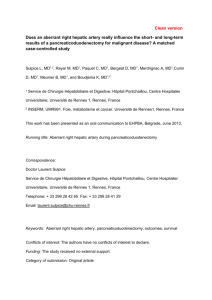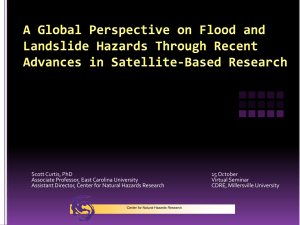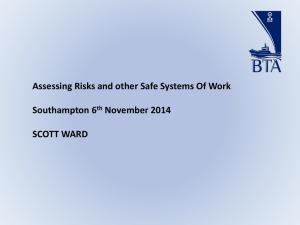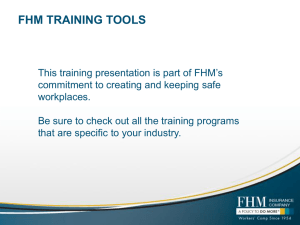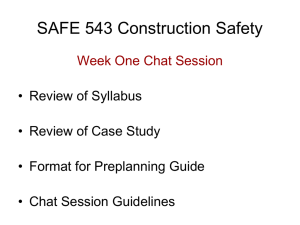PS-SP-#749183-3-AHRA - Presentation - RAUG
advertisement
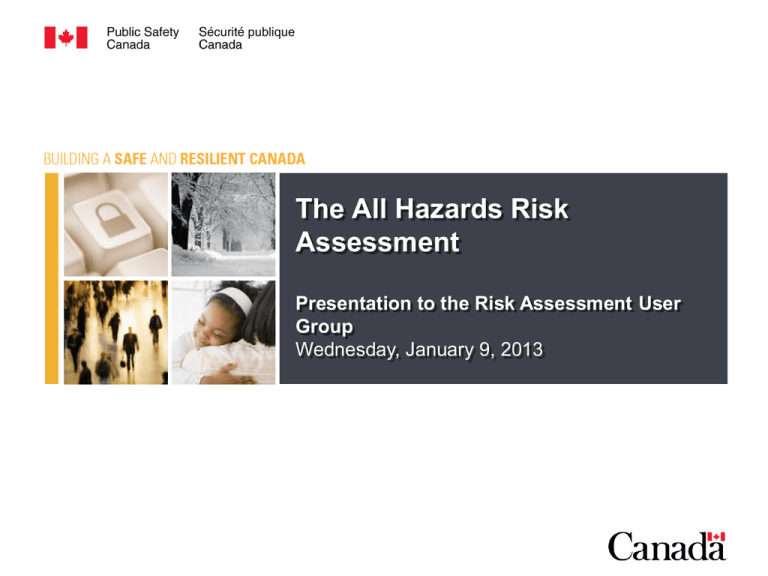
The All Hazards Risk Assessment Presentation to the Risk Assessment User Group Wednesday, January 9, 2013 Outline of the Presentation ● Background of the AHRA ● Principles of the Government of Canada’s All Hazards Risk Assessment (AHRA) initiative ● Demonstrate utility of using an all hazards approach - Science and technological integration - Results from the previous cycles ● The AHRA process - AHRA Taxonomy - AHRA Methodology - Outputs from the AHRA ● Heat maps ● Fiche 1 Background – AHRA ● In 2007, Emergency Management Act (EMA) passed: - Ministers must identify risks within their area of responsibility, prepare plans and maintain, test, implement and exercise those emergency management plans ● In 2007, DRDC CSS began exploring the development of an AHRA ● In 2009, Public Safety began championing the initiative and leads: ● - An interdepartmental consultation to better understand the risk assessment environment - A two-year pilot project to develop an AHRA In 2011, Assistant Deputy Minister (ADM) safety and security level committee is briefed on status of AHRA: ● - Results of the pilot are provided - Approval to proceed with second spiral/cycle of assessments is granted In Winter 2012 results were presented and endorsed by ADM – EMC members 2 Principles – All Hazards Risk Assessment (AHRA) Purpose q • Support effective EM planning in federal institutions through coordinated approach to risk assessment – articulates the Federal Policy for Emergency Management and complements the EM Planning Guide. Federal Scope q • Supports Ministers in meeting their legislative responsibility under the EM Act to identify risks within or related to their mandate and develop EM plans in respect of those risks. All Hazards Approach • A mechanism for assessing and comparing all hazards regardless of the source or vector (whether malicious or non-malicious). Integrated Approach • Provides a Government of Canada picture rather than an individual perspective from each department – supports federal priority setting and Public Safety’s leadership coordination role. 3 A Collaboratively Developed Methodology ● Inspired by risk assessment approaches undertaken by the United Kingdom and the Netherlands ● During the methodology development stage and the pilot process, PS engaged 26 federal institutions ● Smaller working groups have been developed to: - Determine scenarios to address - Validate results - Work on specific aspects of the methodology ● Buy in from federal institutions was key and provided legitimacy for the process ● PS relies on experts from federal institutions who are “closest” to the Impact Category to provide an assessments of the scenario ● Institutions CAN modify the methodology to meet their own planning needs. 4 Process – AHRA Risk Taxonomy Risk Taxonomy All-Hazards Risk Event Categories Adaptive/Malicious Threats Intentional Threats Criminal: - Terrorist Act - Extremist Act - Individual Criminal Act - Organised Crime - Corporate/Insider Sabotage - Corporate Espionage Foreign State: - State-Sponsored Terrorism - Espionage - Act of War Non- Malicious Threats/Hazards Unintentional Threats/Hazards Health Threats/Hazards Social: - Migration - Social Unrest/Civil Disobedience Pandemics/Epidemics: - Human Health Related - Animal Health Related Technical/Accidental: - Spill - Fire - Explosion - Structural Collapse - System Error(s) Yielding Failure Large-Scale Contamination: - Food/Water/Air Contaminant - Environment Contaminant Emerging Phenomena & Technologies: - Biological Science & Technology - Health Sciences - (Re) emerging Health Hazards - Chemical Compounds - Emerging Natural Hazard(s) - Material Science & Engineering - Information Technologies Natural Threats/Hazards Meteorological: - Hurricane - Tornado/Wind Storm - Hail/Snow/ Ice Storm - Flood/Storm Surge - Avalanche - Forest Fire - Drought - Extreme Temperatures Geological: - Tsunami - Earthquake - Volcanic Eruption - Land/Mudslide - Land Subsidence - Glacier/Iceberg Effects - Space Weather Ecological/Global Phenomena: - Infestations - Effects of Over-Exploitation - Effects of Excessive Urbanisation - Global Warming - Extreme Climate Change Conds. CLASSIFICATION 5 Methodology Government of Canada AHRA Process 6 AHRA Methodology – Impact Categories Environment Territorial Security Canada’s Reputation & Influence Economy People Impact Assessment Society & Psycho-social AHRA Methodology – Likelihood / Probability -Two approaches to determine likelihood are used: Likelihood for natural/accidental hazards • Through elicitation, experts provide qualitative judgment by considering overall capability (technical feasibility and enabling capabilities) and intent. Confidence level recorded. Calibration process follows. • Quantitative approach by which experts draw on historical data to determine the probability. Confidence level recorded. Likelihood assessment Likelihood for malicious scenarios 8 Methodology - AHRA Risk Scoring Tool ● An Excel-based spreadsheet was developed to record discussions and impact assessments from federal experts. 9 AHRA Business Cycle 10 Process - Output AHRA Heat Map Risk results for six scenarios aggregated across six impact categories Non-malicious 5 Iso-risk lines Pandemic Influenza 4 People - Economy Marine Oil Spill Impact Impact 3 Environment FMD Canada’s reputation and influence 2 Territorial security Flood Society and psycho-social Listeriosis Increased risk 1 Hurricane 0 0 1 2 Likelihood 3 4 5 11 Process - Output AHRA Scenario Fiche Brief scenario description Collaborative rating of scenario impacts and likelihood Analysis of scenario outcome &graph demonstrating confidence levels 12 Leveraging the AHRA to inform: EM policy & program development Long Term Objective: A National Risk Assessment that identifies risks to Canada and enhances the safety and security of Canadians. Product: National Risk Register Assessing Capabilities Current Scope Training, exercises, lessons learned Emergency management planning AHRA Informing and validating SEMPs National and international collaboration Security & intelligence Explore Expanding AHRA to National Scope Lessons Learned and Leading Practices ● Lessons Learned: - Engage experts early and frequently in development and validation of methodology – builds credibility. - But, be prepared to bring development of methodology to a close and commit to update it on an annual basis – satisfies scientists that new techniques can be incorporated and lets process move forward. - Promote ownership through multilevel governance process that engages scientists/experts as well as senior managers – let colleagues be your ambassadors. - Provide a road map for partners – hard to do when process is new but keeps everyone on board. - Don’t let data gaps stop you – create a “parking lot” for new ideas and assign a lead. ● Leading Practices: - Work through networks to identify the right experts for risk scenarios and risk scoring – experts wanted to be involved and never said “no”. - Be prepared: Experts did research beforehand and came to workshops with data in hand. - Let experts decide: Brought intelligence community together to develop methodology for assessing likelihood of malicious threats. - Sought formal feedback at each stage of process in order to course correct and improve it in subsequent years. - Knowledge transfer: Federal organizations using AHRA Methodology to conduct additional risk assessments and upload their results to whole-of-government process. 14 Success Stories ● AHRA Methodology - Health Portfolio ● Scenarios - Various Federal Exercises ● Collaboration - Collaboration with experts across federal organizations - Collaboration with CSS - Outreach activities - SEMP International - DRM Framework deliverable for G20 Finance Ministers 15 Proposed Forward Approach for AHRA • Expand AHRA for Capability Assessment • Pilot Capability Assessment with a select number of scenarios Step 1: Environmental Scan Step 2: Risk Assessment Step 3: Capability Assessment Step 4: Recommended Options • Explore expanding the scope of the AHRA beyond the federal community to include P/Ts and/or regions • Explore expanding AHRA in select P/Ts or regions 16 Julie Cranton Chief, AHRA and IDO Emergency Management and Planning Division Julie.Cranton@ps-sp.gc.ca Connie Cheung Senior Policy Advisor Emergency Management and Planning Division Connie.Cheung@ps-sp.gc.ca For more information: AHRA-ETR@ps-sp.gc.ca The All Hazards Risk Assessment Methodology Guidelines 2011-2012 were published on the Public Safety Canada (PS) website in July 2012 http://www.publicsafety.gc.ca/prg/em/emp/2012-ahra/index-eng.aspx 17

